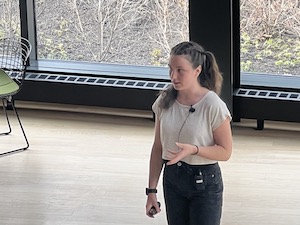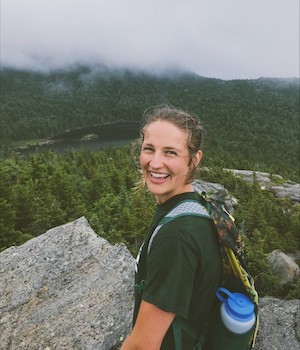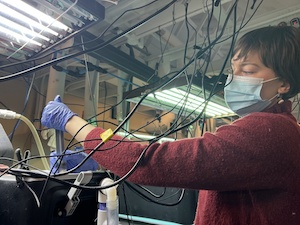Independent Studies
Students should consult with a professor to make arrangements for an independent study at least one semester in advance, since professors are limited in the number of projects they can advise each year. One semester of independent study work, at either the intermediate or advanced level, may be counted toward the major or minor.
Recent Independent Studies

Delaney Bullock ’22
The Use of Kelp and Green Crabs as Soil Amendments in Maine Agriculture
Advisors: Phil Camill and Cathryn Field
Bullock researched the potential of green crabs and kelp as fertilizer amendments—products added to soil to improve it's physical qualities. Turning these two species into soil amendments could have far-reaching benefits: Kelp is a carbon sequester—so the more that is grown the better—and Maine needs to find a way to incentivize green crab trapping to decrease the crustacean's current rampage through coastal ecosystems.

Holly Harris ’22
Resolving the Mystery of the Passagassawakeag Gneiss
Advisor: Emily Peterman
Harris investigated an "enigmatic band of rock" called the Passagassawakeag Gneiss, located north of Brunswick. The seventy-five-kilometer band is a geological mystery with uncertain origins, mostly due to it being highly metamorphosed and deformed during the processes that created the Appalachian Mountains. "Being able to unravel the timing and history of deformation that occurred in these rocks is important to figuring out what happened at the boundaries and to piece together the geological history of the area," Harris said.
Using the age distribution of the zircon dated from each sample, she found that some of the P-Gneiss comes from igneous rock intrusions dating back to 380 million and 450 million years ago—some is a more highly deformed Cape Elizabeth rock, and some of the rock was sourced from an unknown provenance with zircon up to 2 billion years old.
Cameron MacKenzie ’22
Timing and Extent of Holocene Glaciation in the Northeastern Brooks Range, Alaska
Advisors: Emily Peterman, Phil Camill, Michelle Fame
MacKenzie "examined the timing and extent of glacial advances and retreats in the northeastern sector of the Brooks Range, Alaska, since the end of the last major ice age, approximately 11,700 years ago, during the Holocene."

Lucie Nolden ’22
Life in the Dirt: Controls on Nitrogen Mineralization on Organic Farms
Advisor: Phil Camill
"Without human intervention, soil can take care of itself. Robust soil ecosystems cycle nutrients like nitrogen through fixation by bacteria in root nodules, mineralization of organic nitrogen into plant-available forms, and immobilization by plant uptake," Nolden said. "But crop production and fertilizer application can upset soil’s circular nitrogen economy."
Andrew Treat ’22
Trends within the Trench: Characterizing Warming Patterns at the Northeast Channel of the Gulf of Maine
Advisor: Collin Roesler
For his project, Treat worked with a twenty-year data set collected at University of Maine’s N01 hydrographic buoy to analyze long-term trends in temperature, salinity, and density at the Northeast Channel. His goal was to characterize how energy in the form of heat has moved (and will continue to move) into the Gulf of Maine.
Angus Parton ’22
Assessing the Feasibility and Efficacy of CCS Implementation in the US Energy Sector
Advisor: Emily Peterman
Parton researched the feasibility of large-scale implementation of carbon capture and storage (CCS) technologies in the United States energy sector.